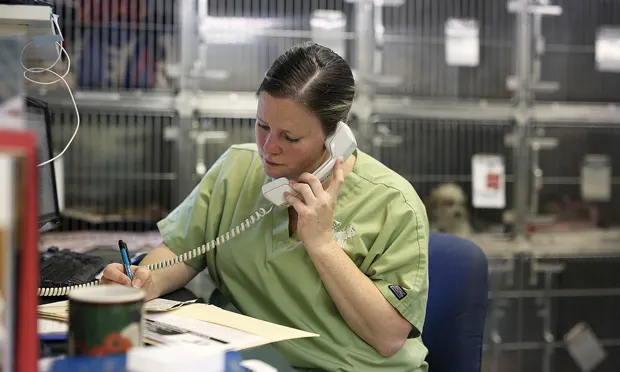The Art of Telephone Triage

Effective telephone triage can enhance your patient care. If your practice does not treat emergency cases, your triage skills can meet the patient’s immediate needs while you refer the client to an emergency practice.
The goals of telephone triage should include good client communication to determine whether the patient needs immediate veterinary attention, as well as client education about the care needed and its urgency. The telephone limits you to verbal communication only, preventing any crucial nonverbal communication or patient assessment normally relied on to make treatment decisions, so your communication skills are crucial in these cases.
Effective Communication for Crucial Information
When you ask questions, remember that the average client does not have medical knowledge. For example, asking about gum color is likely not useful because mucous membrane color assessment is very subjective. Also, the pink shade that is good for a dog is not the same shade that is acceptable for a cat; you cannot expect the client to know that, and you will not be able to describe the exact shade.
When speaking with a client who has called in an emergency, open-ended questions are helpful. For example, Can you tell me what’s going on with Fluffy ? will often receive a more descriptive answer than, So I understand you called today because Fluffy is vomiting. The first question allows the client to explain the whole problem, whereas the second statement will likely lead to a yes or no answer that requires more questioning.
Patient Information & History Are Key
When clients call, make sure they provide the patient’s signalment (ie, age, breed, sex, neuter status), which will help guide your considerations of likely problems for that particular patient. For example, if a client calls about a patient that is straining in the litter box, knowing it is a spayed female cat rather than a neutered male will help you put urinary obstruction further down the list.
A detailed history can also determine if a patient needs veterinary attention; patient histories over the phone can be tailored to include only details that are pertinent to the current problem. For example, you will ask different questions about an acute vomiting patient if that patient has a history of chronic vomiting.
Directing the Call
Sometimes conversations need to be redirected to the matter at hand. Clients commonly call about an acute presentation of a chronic problem and spend time on an extensive history of their pet’s condition. It is entirely appropriate to ask, So what changed today that prompted you to call for emergency care?
When discussing a patient’s condition with a client, first rule out the most life-threatening illnesses. Signs that the client should immediately find emergency care, rather than wait for a regular appointment, include retching or a bloated abdomen (dogs), 2 or more seizures in 24 hours, sustained trauma, irregular breathing, and straining to urinate without producing urine.
Hotlines (ASPCA Poison Control Center and Pet Poison Helpline) are available for clients whose pet has eaten anything potentially toxic. These hotlines are staffed by veterinarians who specialize in toxicities and can provide the latest information about medications and other substances, and advise clients to seek emergency attention if needed. These hotlines usually charge a fee, which generally includes unlimited access to their services as long as it pertains to the original case.
Although telephone triage can be difficult, it is an essential part of helping clients get their pet the necessary emergency care. It is useful even for clients who call about a nonemergent condition, because it provides them with peace of mind and the knowledge they are caring for their pet appropriately.
This article originally appeared in the October 2014 issue of Veterinary Team Brief.